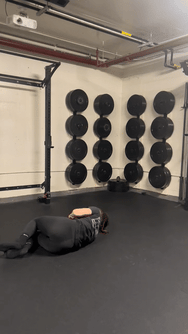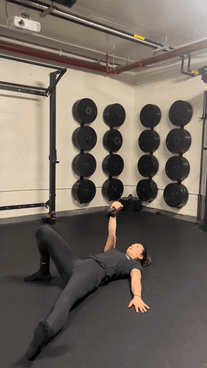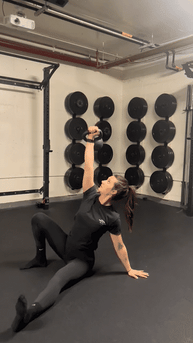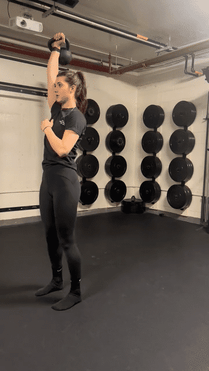Coaching Cues - How to do the Turkish Get Up
April 8, 2022
The Turkish Get Up, from the outside looks like a crazy series of steps but is a staple exercise for our team here at MOTIVNY. This movement alone trains shoulder and trunk stability, mobility and lots of total body control as you move through multiple planes of motion.
Intro to the TGU
.gif?width=572&name=ezgif.com-gif-maker%20(5).gif)
The TGU as many put it or The Turkish Get Up is one of the most important kettlebell exercises created. This series of movements demands stability, mobility, and coordination, all while building strength.
A movement like this can be used and programmed in a variety of ways all based around the goal behind the pattern. For my own training and injuries I programmed in the Turkish Get Up to focus on shoulder stability. Throughout the series of movements you must be able to maintain control of a bell overhead.
There are so many other ways to program this in that works best for your body wether it's as a dynamic warmup, superset of a strength block or as a loaded mobility on a rest day. Whatever it is, it is imperative that as we age we learn how to navigate getting up and safely down to the ground. I'll show you how to execute a TGU safely along with bringing awareness to common errors or mistakes we want you to avoid.
Turkish Get Up benefits
For those who have no idea what this movement even looks like, this is a single arm kettlebell movement. Focusing on the shoulder, trunk, core, hips and lower body. Working stability, loaded mobility, and teaching you spacial awareness which in turn carries over to improving full body control and strength. This is one of the only movement patterns you'll see where you must move your body around a fixed object.
As I had said earlier the TGU has so many different benefits, it then raises the question why or what is the goal behind including it in your programming. A shoulder stability drill, trunk stability, loaded mobility, learning to safely get off the ground or just to work on coordination, all are viable and very important goals or "whys" to include the TGU.
Turkish Get Up Cues and Demonstration
1). Lying on your right side in fetal position, both hands on the bell, roll onto your back with the bell lying on your chest. In starting position (half star fish), your right leg will be bent bringing your heel close to your butt. Left leg extended on a 45 degree angle with your foot flexed toes pointing to the sky.

2). Both hands press the bell up over your chest, knuckles towards the ceiling keeping a straight arm at all times. Place left arm parallel to the left leg, driving your left heel into the ground. Using tension in your left hand and scapula perform a rolling motion reaching towards the left leg, while pulling the ground towards you to get up to your left forearm. Watch the bell the whole time, push up onto your left wrist.


3). Sweep your left leg under your body maintaining shoulder stability, your knee landing about 5 inches behind your left wrist creating a 90 degree angle between your two legs. Shift your weight into your right hip, releasing your hand from the ground. Engaging your glutes and coming up to extension. This set up is called a half kneeling windmill.
4). Straightening out the back leg both hips pointing forward, the bell will now be directly overhead. Set up in half kneeling position or the bottom of a Single Arm Overhead Lunge. Push through left foot and front right heel coming out of the lunge to standing position (top of the TGU)
.

5). Maintaining control decelerate yourself back down into the same side lunge. Windshield wiper the left leg, to our windmill. Looking at the bell, trace the left thigh with the left hand to find the ground and reaching forward of the knee. Press into the left hand and right heel, don't let right knee collapse, sweep the left leg back through as your butt contacts the ground.
6). Putting tension in the left leg, keeping shoulder away from the ear slowly lower your upper body from wrist down to the left elbow. Create max tension in your trunk and roll onto your back without collapsing, Finishing back in out half starfish position.
Some common mistakes or sticky points in the Turkish Get Up
As you just saw the Turkish Get Up has a lot going on at once, and is not something you will see in the everyday gym workout. It is a very dynamic movement that if not done properly can lead to injury or some sticky situations, as like every exercise.
1). When rolling onto the elbow the straight leg will lift up, meaning a loss in trunk stability and control.
2). In the tall seated starfish position, letting your weight sink into the ground based shoulder, losing scapular depression and lat activation, causing the shoulder to roll forward.
3). Letting the arm holding the bell bend, or sink into the joint. You must always be active while the wait is overhead. Pushing the knuckles towards the sky and keeping a straight arm is imperative.
4). When sweeping the leg through, not getting the knee far enough under your trunk, creating a sort of back bend set up from your spine and making it almost impossible to stabilize the bell and load your hips.
5). Your toes are your biggest little helper. They are what help you feel stable when in your half kneeling windmill set up that creates tension as you load the hips. They also help you push up to the standing position, our toes are the roots to the rest of our movement. Without using them we lose power and stability.
6). MAKE SURE YOU BREATHE!! It is so easy to get so caught up in all of this craziness so take it step by step this isn't designed to be a fast movement. Control each position and use your breathe to guide you.
So, why the TGU
This one pattern incorporates more movements and benefits into one than any other in my opinion. Stability, mobility, flexibility, strength, spacial awareness, coordination, and a whole lot of focus. Working in so many patterns you are already accustomed to in the gym setting, a hinge, lunge, core, some scapular depression (lat activation), and pressing. tying it all together. Something like this will take time to master so give yourself grace. It is also a pattern that should be programmed and put to work in low volume and reps to get your maximum benefits out of it.
Want to learn how to Turkish Get Up??

